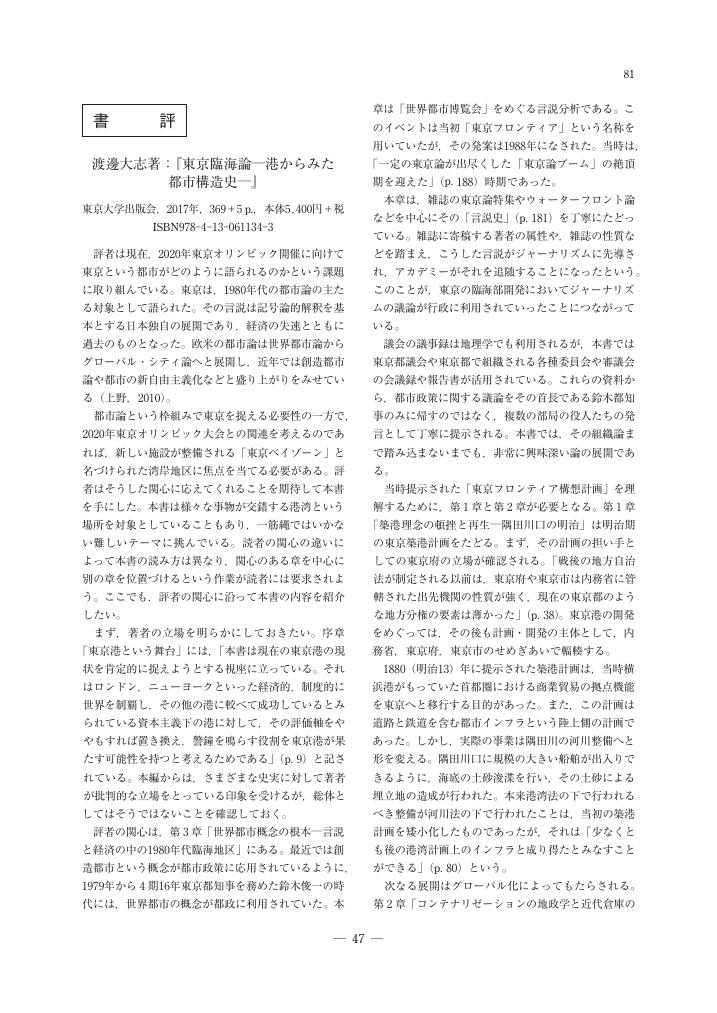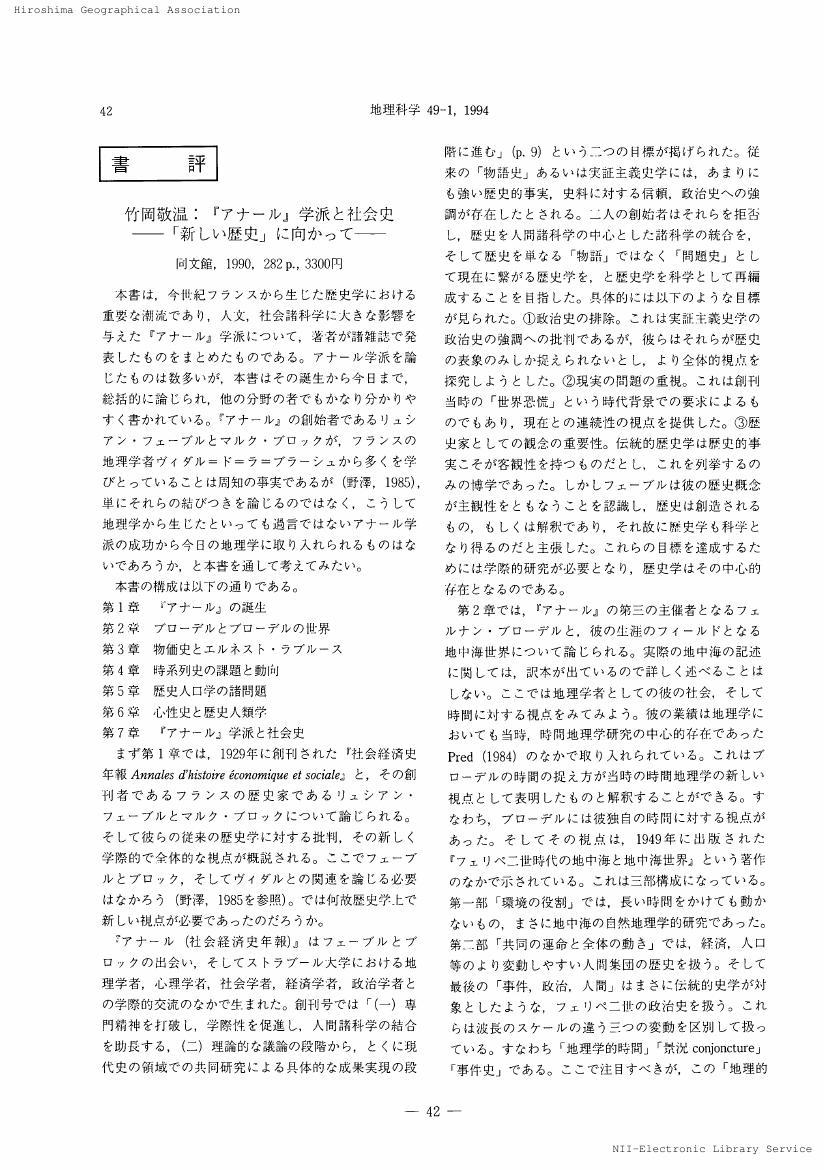1 0 0 0 OA 複雑化する「結びあい」 : 戦後兵庫県における沖縄出身者の都市生活
- 著者
- 山口 覚
- 出版者
- 地理科学学会
- 雑誌
- 地理科学 (ISSN:02864886)
- 巻号頁・発行日
- vol.57, no.1, pp.23-44, 2002-01-28 (Released:2017-04-20)
- 参考文献数
- 46
- 被引用文献数
- 1
Since islands of Okinawa was incorporated into Japan, many Okinawan people have been in a little difficult position. For example, the migrants from Okinawa in the cities of mainland Japan (Hondo) were often discriminated in the employment opportunities. And because islands of Okinawa was ruined in World War II, many Okinawan migrants were left in the mainland, and they had to live in the postwar severe situation. In this paper, I will examine the urban lives of Okinawan migrants in Hyogo prefecture (especially postwar Amagasaki, Takaradsuka, Itami and Kobe city) and their various forms of networks, groups and places to live in and to resist oppressed situation. The association of people from Okinawa prefecture (Okinawa-Kenjinkai-Hyogoken-Honbu) was one of the most cohesive group, it was made by `Okinawa' as a social category and as a symbol of concentration for some social and political purposes. In Amagasaki and Takaradsuka city, these cohesions like Kenjinkai had made it possible for some assemblymen who were native of Okinawa to win the local elections, for example. When the people who lived in the concentrated areas had some political purposes, these areas became the cohesive places to resist their opponents. But these cohesions were ad hoc. Because each migrants lived in different geographical and social context, their each individual living strategies and tactics were complicated, and each migrants had extended their own personal networks which included neighbors who were not native of Okinawa. So even in their concentrated areas, their individual social and political senses were not always in unison. Okinawan migrants had become urbanites in urban settings. It is said that discrimination in the employment opportunities was to some extent eased in the high-growth period, so their lives have changed for the better. And the main role of Kenjinkai have become enhancing mutual friendship.
1 0 0 0 OA 山田安彦編, 方位と風土, 古今書院, 1994,288p., 5665円
- 著者
- 佐々木 卓也
- 出版者
- 地理科学学会
- 雑誌
- 地理科学 (ISSN:02864886)
- 巻号頁・発行日
- vol.50, no.4, pp.316-318, 1995 (Released:2017-04-20)
1 0 0 0 OA 筑後川下流における対岸飛地の生活圏 : 昭和59年度地理科学学会大会発表要旨
- 著者
- 平川 聡
- 出版者
- 地理科学学会
- 雑誌
- 地理科学 (ISSN:02864886)
- 巻号頁・発行日
- vol.39, no.3, pp.145-146, 1984 (Released:2017-04-20)
1 0 0 0 OA 岩手県遠野市における南部曲家の現状 : その残存と継承に着目して
- 著者
- 河本 大地
- 出版者
- 地理科学学会
- 雑誌
- 地理科学 (ISSN:02864886)
- 巻号頁・発行日
- vol.58, no.1, pp.46-59, 2003-01-28 (Released:2017-04-15)
- 参考文献数
- 29
In recent years, organized landscape conservation has increased in rural Japan, and it has often been conducted by means of subsidies, tight rules and management activities in small special areas. However, in the other general rural areas, it is more than probable that the situation of surviving traditional elements is considerably different. The purposes of this paper are; 1) to clarify how nanbu-magariya, traditional L-shaped rural houses in Iwate Prefecture, northern Japan, have survived in the area of Tohno City, which once had many magariya and now has no organized conservation for them, and 2) to examine how the case of nanbu-magariya in Tohno has corresponded to the general trend for recognizing traditional elements as regional resources. The results were as follows : 1) There are 79 surviving magariya in Tohno. They consist of two types; 'left type', which has just been used as storage for decades after building new residential houses in the neighborhood, and 'inherited type', which has been used continuously as a residential house. The former has deteriorated seriously. 2) Magariya have survived due to the relative financial difficulties of the owners, as well as the affirmative consciousness for their life in the magariya. 3) Most of the magariya have been maintained by the residents who wish to continue to live with improved living conditions. Several residents have tried to maintain the thatched roofs, in spite of the difficulty of obtaining thatch and thatchers. 4) Several inherited cases of magariya were detected besides the residential survival. Many of them had been moved from the original places to be preserved and used for tourism. Moreover, several new residential houses that imitated the style of magariya have been built as a result of the owner's nostalgia. These inherited cases have appeared through the understanding of magariya as regional symbolic resources. The 'image of the region' without the substantial 'tradition' forms the landscape of present Tohno, while real residential magariya are on the verge of disappearance.
1 0 0 0 OA 北隆地方における工業地域の発展と性格
- 著者
- 村上 誠
- 出版者
- 地理科学学会
- 雑誌
- 地理科学 (ISSN:02864886)
- 巻号頁・発行日
- vol.3, pp.134-142, 1964-09-01 (Released:2017-04-08)
- 出版者
- 地理科学学会
- 雑誌
- 地理科学 (ISSN:02864886)
- 巻号頁・発行日
- vol.29, pp.65-66, 1978 (Released:2017-04-15)
1 0 0 0 OA 渡邊大志著:『東京臨海論―港からみた都市構造史―』
- 著者
- 成瀬 厚
- 出版者
- 地理科学学会
- 雑誌
- 地理科学 (ISSN:02864886)
- 巻号頁・発行日
- vol.73, no.2, pp.81-82, 2018-06-28 (Released:2019-08-21)
- 参考文献数
- 1
- 著者
- 成瀬 厚
- 出版者
- 地理科学学会
- 雑誌
- 地理科学 (ISSN:02864886)
- 巻号頁・発行日
- vol.65, no.1, pp.51-54, 2010-01-28 (Released:2017-04-14)
- 著者
- 成瀬 厚
- 出版者
- 地理科学学会
- 雑誌
- 地理科学 (ISSN:02864886)
- 巻号頁・発行日
- vol.56, no.2, pp.124-126, 2001-04-28 (Released:2017-04-20)
- 著者
- 成瀬 厚
- 出版者
- 地理科学学会
- 雑誌
- 地理科学 (ISSN:02864886)
- 巻号頁・発行日
- vol.54, no.2, pp.138-140, 1999-04-28 (Released:2017-04-20)
- 著者
- 成瀬 厚
- 出版者
- 地理科学学会
- 雑誌
- 地理科学 (ISSN:02864886)
- 巻号頁・発行日
- vol.52, no.4, pp.259-260, 1997-10-28 (Released:2017-04-20)
- 著者
- 成瀬 厚
- 出版者
- 地理科学学会
- 雑誌
- 地理科学 (ISSN:02864886)
- 巻号頁・発行日
- vol.50, no.3, pp.214-215, 1995-07-28 (Released:2017-04-20)
- 被引用文献数
- 2
- 著者
- 成瀬 厚
- 出版者
- 地理科学学会
- 雑誌
- 地理科学 (ISSN:02864886)
- 巻号頁・発行日
- vol.49, no.1, pp.42-44, 1994 (Released:2017-04-27)
- 著者
- 中澤 高志
- 出版者
- 地理科学学会
- 雑誌
- 地理科学 (ISSN:02864886)
- 巻号頁・発行日
- vol.70, no.3, pp.122-141, 2015-09-28 (Released:2017-02-13)
- 被引用文献数
- 1
- 著者
- 中里 亜夫
- 出版者
- 地理科学学会
- 雑誌
- 地理科学 (ISSN:02864886)
- 巻号頁・発行日
- vol.54, no.3, pp.195-202, 1999
- 参考文献数
- 13
1 0 0 0 OA 潟湖干拓地の圃場整備 : 九十九里平野椿梅干拓地域
- 著者
- 白井 義彦
- 出版者
- 地理科学学会
- 雑誌
- 地理科学 (ISSN:02864886)
- 巻号頁・発行日
- vol.11, pp.4-16, 1969-05-20 (Released:2017-04-14)
We are inclined to consider that we should be able to plan out an unrestrained program of the readjustment of the arable land in many lagoons beside the coastal plains in Japan because they have few existing conditions, newly-developed, as compared with the general alluvial plains. In the present study as a preparatory work to the regional examination of the methods of readjusting the arable land in Japan, I took up the example of the lagoon land improvement section in Chiba Prefecture (Tsubakiumi Drained Reclamation Land) as a studying object, and studied how for the methods of readjusting the arable land has been determined by the natural, social and economic conditions in the lagoon. Consequently I pointed out that the methods of readjustment in this area have not necessarily been determined by the shortcoming of the draining function of the Shinkawa River as the draining river of the lagoon, but by the poor waterway function of the Otone Irrigation Water as the reservoir in this area. Therefore the methods of readjustment of the arable land, which should be naturally determined by the choice of the system of farm management by the farmers, must have been temporizing ones.
- 著者
- 福岡 義隆
- 出版者
- 地理科学学会
- 雑誌
- 地理科学 (ISSN:02864886)
- 巻号頁・発行日
- vol.41, no.3, pp.179-180, 1986 (Released:2017-04-20)
- 著者
- 吉田 雄介
- 出版者
- 地理科学学会
- 雑誌
- 地理科学 (ISSN:02864886)
- 巻号頁・発行日
- vol.59, no.2, pp.67-87, 2004-04-28 (Released:2017-04-15)
- 参考文献数
- 25
This study examines the geographical diffusion of the household industry in Iran on the basis of national censuses of 1956, 1966 and 1976. I hope to identify first, in a rough way, a beginning of disappearance of regional variety of household industry. And finally I sketch out the process of homogeneization of household industry by the Persian carpet production. According to the difference of physical environment and condition of agricultural production, there has been very regional difference of these industries in Iran. There has been two worlds of household industries which on one hand spinning and weaving industry has flourished in the eastern region of Iran, on the other hand carpet industry had flourished in the western. So we can distinguish these regionalities in the 1956 census. However, in the 1966 these remarkable features were undermined very much because without carpet industry household industries (in especial weaving industry) experienced dramatically decline. While regional specialization also had disappeared throughout Iran, new space of household industry by carpet production had appeared till the 1976. Carpet production closely has been linked with markets of developed countries. The growth of new household industry and the monoculturalization by carpet industry clearly implied the fact that through carpet production every household were directly linked with global demand.
1 0 0 0 最終氷期以降の気候変動とモンスーン
- 著者
- 安田 喜憲
- 出版者
- 地理科学学会
- 雑誌
- 地理科学 (ISSN:02864886)
- 巻号頁・発行日
- vol.42, no.2, pp.113-119, 1987
- 被引用文献数
- 1
A comparative study of the Japanese pollen records to the oxgen and carbon-isotope/pollen records from the Arabian Sea, Bengal Bay and Andaman Sea suggests the following summer monsoon fluctuations since the last glacial age in Japan. Ca. 120,000-70,000 years B.P.; Monsoon is active. 70, OO0-50, OOO years B.P.; Monsoon is not active. 50,000-33,000 years B.P.; Monsoon is rather active. 33,000-12,000 years B.P.; Monsoon is not active. But from 28,000 to 25,000 years B.P. is slightly active. 12,000-10,000 years B.P.; Monsoon is to move active. after 10,000 years B.P.; Monsoon is active.
1 0 0 0 OA 2000年代における京都市のコンビニエンスストアの立地
- 著者
- 荒木 俊之
- 出版者
- 地理科学学会
- 雑誌
- 地理科学 (ISSN:02864886)
- 巻号頁・発行日
- vol.67, no.4, pp.191-204, 2012-11-28 (Released:2017-04-14)
- 参考文献数
- 18
- 被引用文献数
- 1
The purpose of this research is to clarify the locational characteristics and locational patterns of convenience stores (CVS) in Kyoto City in the 2000s (2001-2010). The findings are as follows. 1) CVS became more concentrated in the central business district in the urban core during the second half of the 1990s in Kyoto City. This tendency is also seen in the 2000s. 2) Since 2000, the proportion of CVS located on shopping streets has been decreasing. In comparison, the proportion of CVS located near railway stations has been increasing. 3) The tendency to spread into various areas progressed further. It was seen that there are diverse types of CVS in Kyoto City. Since the late 1990s and through the 2000s, the population growth of Kyoto City has occurred in the urban core along with the development of condominiums. The locations of CVS are keeping pace with the increase in population in the urban core. The locational patterns of CVS in the cities of Kyoto, Okayama, and Takamatsu were in accordance with the suburbanization of the population till the first half of the 1990s. Since the second half of the 1990s, the locational patterns of CVS in these cities were in accordance with population movement back to the city. This tendency in Kyoto City for CVS location was also seen in the cities of Okayama and Takamatsu. After 2000, when the growth in the number of CVS slowed down, the tendency between these three cities for CVS location became different.












